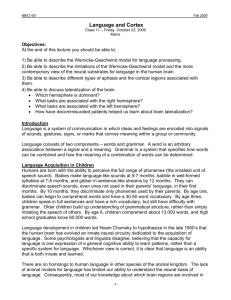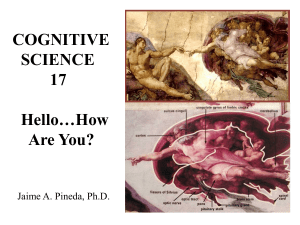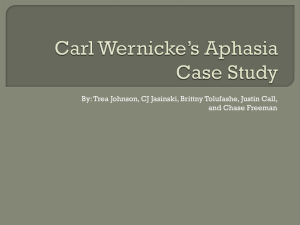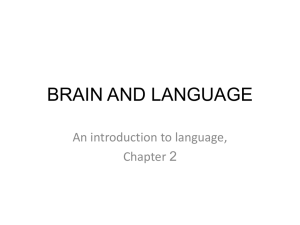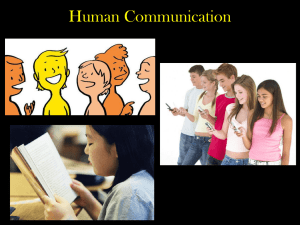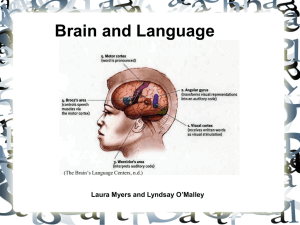Chapter 16 Slides - Part 2
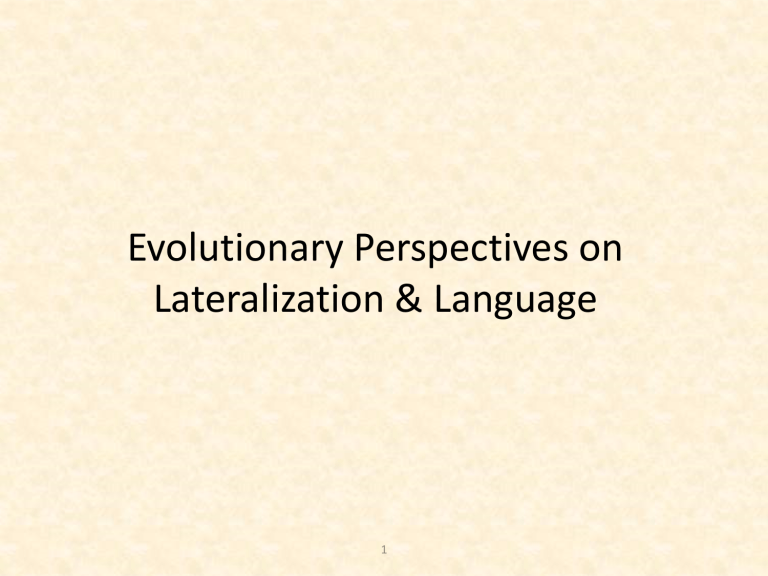
Evolutionary Perspectives on
Lateralization & Language
1
Theories of the Evolution of
Cerebral Asymmetry
• 3 main theories of cerebral lateralization
• General premise: Advantageous for brain areas that perform similar functions to be located in same hemisphere
• Each theory proposes a different fundamental distinction between LH and RH
2
Analytic-Synthetic Theory
• Two basic modes of thinking, analytic (left) and synthetic (right)
• Vague and essentially untestable
• “The darling of pop psychology”
3
Motor Theory
• Left hemisphere specialized not for the control of speech specifically but fine movements (e.g. speech)
• Support from findings that lesions to LH that produce aphasias often produce motor deficits
• Why did motor function become lateralized?
4
Linguistic theory
• Primary role of left hemisphere is language
• In the other 2 theories, language is a secondary specialization
• Based on evidence from studies of ASL deaf individuals
• LH damage disrupts sign language but not complex pantomime gestures
5
When Did Cerebral Lateralization Evolve?
• Until recently, lateralization of function assumed unique to hominin brain (i.e. specialization of motor control for tool use)
• Recent evidence of lateralization of function in earlier vertebrates
• Right-handedness possibly evolved from a preference for use of the right side of the body for feeding
• Left-hemisphere dominance for communication present in species that existed prior to humans (e.g. birds, dogs, & monkeys)
6
Survival Advantages of Cerebral
Lateralization?
• In some cases, increased neural efficiency by concentrating a function in one hemisphere
• Two cognitive processes may be more readily performed simultaneously if they are lateralized to different hemispheres
7
Evolution of Human Language
• Human communication is different from communication of other species
• Human language allows virtually limitless expression by combining a finite set of elements
• The language instinct
• Infant language
• Words leave no fossils
8
Evolution of Human Language
• Nonhuman primates appear to have more ability in comprehending sounds vs. making vocal calls
• Humans possess fine motor control over speech
• This fits with the “motor theory of speech perception”: posits that there is overlap between speech comprehension and motor regions involved in speech production
• Chimpanzees have a highly nuanced vocabulary of hand gestures
– May indicate a stage in the development of human language
9
Cortical Localization of Language:
Wernicke-Geschwind Model
• Language localization – place within the hemisphere of language circuitry
• Wernicke-Geschwind Model
– The predominant theory of language localization
10
Historical Antecedents of the
Wernicke-Geschwind Model
• Broca’s area – speech production
– Damage leads to expressive aphasia
– Normal comprehension; speech is meaningful, but halting & labored
• Wernicke’s area – speech comprehension
– Damage causes receptive aphasia
– Poor comprehension; speech sounds normal, but have no meaning (“word salad”)
11
Patients Speech
• Broca’s Aphasia
– “Yes . . . Monday . . . Dad and Dick . . .
Wednesday nine o’clock . . .ten o’clock doctors .
. . and . . .teeth.” (Geschwind, 1980)
• Wernicke’s Aphasia
– “Mother is away here working her work to get her better, but when she’s looking the two boys looking in the other part. She’s working another time.” (Geschwind, 1980)
FIGURE 16.10 The seven components of the Wernicke-Geschwind model.
13
Historical Antecedents of the
Wernicke-Geschwind Model
Continued
• Arcuate fasciculus – connects Broca’s and
Wernicke’s areas
– Damage causes conduction aphasia (inability to repeat words just heard)
– Comprehension and speech normal
• Left angular gyrus – posterior to Wernicke’s area
– Damage causes alexia (inability to read) and
agraphia (inability to write)
14
FIGURE 16.10 The seven components of the Wernicke-Geschwind model.
15
The Wernicke-Geschwind Model
• Norman Geschwind integrated the ideas of
Broca, Wernicke, and Dejerine into into a complete model of language processing
• Involves seven components, all of which are in the left hemisphere
16
FIGURE 16.11 How the Wernicke-Geschwind model works in a person who is responding to a heard question and reading aloud. The hypothetical circuit that allows the person to respond to heard questions is in green; the hypothetical circuit that allows the person to read aloud is in black.
17
Wernicke-Geschwind Model: The
Evidence
• Original evidence based on neurological case studies of aphasias due to stroke, tumors, & injuries
• Problem of diffuse damage to other areas
• Lack of evidence that damage to various parts of the cortex has expected effects
– Surgery that destroys only Broca’s area has no lasting effects on speech
– Removal of much of Wernicke’s area has no lasting effects on speech
18
Area of Damage in one of Broca’s Patients
Like this patient, most aphasic patients have diffuse brain damage. It is thus difficult to determine from studying them the precise location of particular cortical language areas.
19
Effects of Cortical Damage on
Language Abilities
• No aphasic patients have damage restricted to Broca’s or
Wernicke’s areas
• Aphasics almost always have damage to subcortical white matter
• Large anterior lesions most likely to produce expressive symptoms
• Large posterior lesions most likely to produce receptive symptoms
• Global aphasia is usually related to massive lesions of several regions
• Aphasics sometimes have damage that does not encroach on
Wernicke-Geschwind areas
20
FIGURE 16.13 The lack of permanent disruption of language-related abilities after surgical excision of the classic Wernicke-Geschwind language areas. (Based on Penfield & Roberts, 1959.)
21
Effects of Electrical Stimulation to the Cortex on Language Abilities
• Stimulated sites that affected language were not necessarily within the boundaries of the
Wernicke-Geschwind language areas
• There were major differences between subjects in the organization of language abilities
22
Effects of Electrical Stimulation to the Cortex on Language Abilities
23
Current Status of the Wernicke-
Geschwind Model
• Empirical evidence supports two elements
– Important roles played Broca’s and Wernicke’s – many aphasics have damage in these areas
– Anterior damage associated with expressive deficits and posterior with receptive
• No support for more specific predictions
– Damage limited to identified areas has little lasting effect on language
– Brain damage in other areas can produce aphasia
– Pure aphasias (expressive OR receptive) rare
24

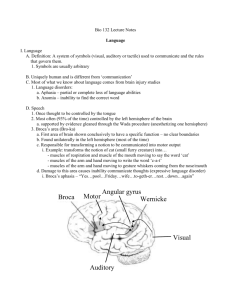
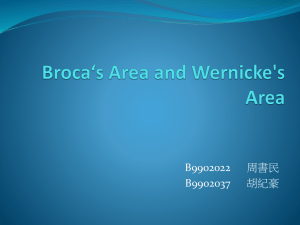
![Wernicke`s_area_presentation[1] (Cipryana Mack)](http://s2.studylib.net/store/data/005312943_1-7f44a63b1f3c5107424c89eb65857143-300x300.png)
